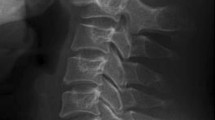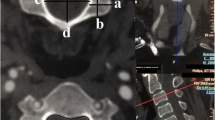Abstract
Purpose
Os odontoideum is a rare anatomical and morphological variation of the odontoid process and associated with a range of symptoms such as spinal cord and vertebral artery injuries. This study aimed to evaluate the frequency of os odontoideum in Turkish cases by sagittal/coronal cervical magnetic resonance imaging (MRI) and computed tomography (CT) and analyze the relationship with age, gender and related symptoms.
Methods
The incidence of os odontoideum was retrospectively diagnosed by sagittal/coronal cervical CT and MRI out of 16,122 subjects aged 20–70 years (mean 46) in the period between 2014 and 2018. The relationship of os odontoideum with age, gender, and symptoms was recorded.
Results
The statistical analysis of the study was performed by the χ² test and two-way mixed ANOVA. Os odontoideum was detected in 18 (0.11%) (11 males; 7 females) out of 16,122 patients. The mean age was 47.5 ± 1.4 years in the females and 43.5 ± 2.5 years in the males (p < 0.05). 6 odontoideum were detected out of 6467 (3756 males, mean 48 ± 0.7, 2711 females, mean 46 ± 1.2) subjects by CT and 12 odontoideum were detected out of 9655 patients (5607 males and 4048 females) by MRI.
Conclusion
Neck pain was the most frequent symptom. The prevalence of os odontoideum especially round type is more frequent in older male patients over 40 years old with head and neck pain or atlantoaxial instability, and is less common in Turkish subjects when compared to various ethnic groups.




Similar content being viewed by others
Abbreviations
- CVJ:
-
Craniovertebral junction
- CT:
-
Computed tomography
- DO:
-
Dystopic odontoideum
- FM:
-
Foramen magnum
- MRI:
-
Magnetic resonance imaging
- OC:
-
Ossification center
- OO:
-
Orthotopic odontoideum
- OP:
-
Odontoid process
- POC:
-
Primary ossification center
- SOC:
-
Secondary ossification center
References
Abe H, Tsuru M, Mitsumori K (1976) Atlantoaxial dislocation, instability index, and indications for surgery. Neurol Surg 4(1):57–72
Akobo S, Rizk E, Loukas M, Chapman JR, Oskouian RJ, Tubbs RS (2015) The odontoid process: a comprehensive review of its anatomy, embryology, and variations. Childs Nerv Syst 31(11):2025–2034
Aljeeran OI, Kuwari KM, Almayman T, Butt AJ (2018) A rare late presentation of os-odontoideum with severe progressive myelopathy. Bahrain Med Bull 40(1):46–48
Altun I, Yuksel KZ (2017) An uncommon case mimicking cervical trauma: os odontoideum. Turk J Emerg Med 17(1):22–24
Baumgart M, Wisniewski M, Grzonkowska M, Malkowski B, Badura M, Dabrowska M, Szpinda M (2016) Digital image analysis of ossification centers in the axial dens and body in the human fetus. Surg Radiol Anat 38(10):1195–1203
Baumgart M, Wisniewski M, Grzonkowska M, Malkowski B, Badura M, Dabrowska M, Szpinda M (2016) Morphometric study of the neural ossification centers of the atlas and axis in the human fetus. Surg Radiol Anat 38(10):1205–1215
Cakir M, Sade R, Ogul H, Calikoglu C, Karaca L, Kantarci M (2015) Medial condyle with os odontoideum that has fused to the occiput. Spine J 15(5):1152–1153
Choi D, Abrahams P (1997) An atlas vertebra with a centrum? A case report of an abnormal atlas and axis. Surg Radiol Anat 19(4):269–271
Dai L, Yuan W, Ni B, Jia L (2000) Os odontoideum: etiology, diagnosis, and management. Surg Neurol 53(2):106–109
Dhadve RU, Garge SS, Vyas PD, Thakker NR, Shah SH, Jaggi ST, Talwar IA (2015) Multidetector computed tomography and magnetic resonance imaging evaluation of craniovertebral junction abnormalities. N Am J Med Sci 7(8):362–367
Gluf WM, Schmidt MH, Apfelbaum RI (2005) Atlantoaxial transarticular screw fixation: a review of surgical indications, fusion rate, complications, and lessons learned in 191 adult patients. J Neurosurg Spine 2(2):155–163
Goel A, Patil A, Shah A, Dandpat S, Rai S, Ranjan S (2019) Os odontoideum: analysis of 190 surgically treated cases. World Neurosurg 1878–8750(19):32735–32744
Jumah F, Alkhdour S, Mansour S, He P, Hroub A, Adeeb N, Hanif R, Mortazavi M, Tubbs RS, Nanda A (2017) Os odontoideum: a comprehensive clinical and surgical review. Cureus 9(8):1551
Le Pape S, Gauthe R, Latrobe C, Leroux J, Roussignol X, Ould-Slimane M (2016) Cervical myelopathy involving os odontoideum and retro-odontoid cyst treated with Harms C1–C2 arthrodesis. Orthop Traumatol-Surg Res 102(6):817–820
Lee DY, Jeong ST, Lee TH, Kim DH (2018) Brown-Sequard syndrome caused by hyperextension in a patient with atlantoaxial subluxation due to an os odontoideum. Acta Orthop Et Traumatol Turc 52(3):240–243
Matsui H, Imada K, Tsuji H (1997) Radiographic classification of os odontoideum and its clinical significance. Spine 22(15):1706–1709
McRAE DL (1953) Bony abnormalities in the region of the foramen magnum: correlation of the anatomic and neurologic findings. Acta Radiol 40(2–3):335–354
Ni B, Wu L, Guo Q, Lu X, Chen F, Guo X (2016) Posterior open reduction and interlaminae compression fusion for os odontoideum with atlantoaxial dislocation. World Neurosurg 91:326–331
Perdikakis E, Skoulikaris N (2014) The odontoid process: various configuration types in MR examinations. Eur Spine J 23(5):1077–1083
Rahimizadeh A (2016) Os odontoideum: review article. Orthop Res Traumatol Open J 2:6–28
Ricciardi JE, Kaufer H, Louis DS (1976) Acquired os odontoideum following acute ligament injury. Report of a case. J Bone Joint Surg Am 58(3):410–412
Robson KA (2011) Os odontoideum: rare cervical lesion. West J Emerg Med 12(4):520–522
Rozzelle CJ, Aarabi B, Dhall SS, Gelb DE, Hurlbert RJ, Ryken T, Theodore N, Walters BC, Hadley MN (2013) Os odontoideum. Neurosurgery 72(3):159–169
Sankar WN, Wills BP, Dormans JP, Drummond DS (2006) Os odontoideum revisited: the case for a multifactorial etiology. Spine 31(9):979–984
Shetty GM, Song HR, Unnikrishnan R, Suh SW, Lee SH, Hur CY (2007) Upper cervical spine instability in pseudoachondroplasia. J Pediatr Orthop 27(7):782–787
Soni V, Kundu RK, Sankhla A (2019) Evaluation of craniovertebral junction abnormalities with the help of magnetic resonance imaging and multidetector computed tomograph. Int J Sci Res 8(3):34–38
Spierings EL, Braakman R (1982) The management of os odontoideum. Analysis of 37 cases. J Bone Joint Surg Br 64(4):422–428
Straus D, Xu S, Traynelis VC (2014) Os odontoideum in identical twins: comparative gene expression analysis. Surg Neurol Int 20(5):37
Truumees E (2008) Os odontoideum. In: Mann RW, Lozanoff S, Charles C (eds) Photographic regional atlas of non-metric traits and anatomical variants in the human skeleton. Thomas Pub Ltd, New York
Watanabe M, Toyama Y, Fujimura Y (1996) Atlantoaxial instability in os odontoideum with myelopathy. Spine 21(12):1435–1439
White D, Al-Mahfoudh R (2016) The role of conservative management in incidental os odontoideum. World Neurosurg 88(695):15–17
Worley G, Shbarou R, Heffner AN, Belsito KM, Capone GT, Kishnani PS (2004) New onset focal weakness in children with down syndrome. Am J Med Genet A 128A(1):15–18
Zhang H, Jin A, Zhang L, Zhou Z, Duan Y, Min S (2012) Posterior fixation and fusion for treatment of Ss odontoideum complicated by atlantoaxial dislocation. Nan Fang Yi Ke Da Xue Xue Bao 32(9):1358–1361
Zussman BM, Saldua NS, Harrop JS (2012) Cervical instability presenting as thoracic pain: case report and literature review. J Spinal Cord Med 35(2):125–127
Acknowledgements
We thank the Department of Anatomy and Neurosurgery of Akdeniz University. We also thank the Department of Neurosurgery of Antalya Training and Research Hospital, University of Health Sciences.
Author information
Authors and Affiliations
Contributions
EÖ, RŞ, NKÇ contributed to the development of the project, study design and drafting of the manuscript. HŞ, HÇ, TG are involved in data collection. EÖ, RŞ, NKÇ contributed to the data management. EÖ, RŞ, HŞ, TG analyzed the data. EÖ participated in the writing of the manuscript. All authors have read and approved the final manuscript.
Corresponding author
Ethics declarations
Conflict of interest
The authors have no conflict of interest to declare in relation to the information contained in this article.
Additional information
Publisher's Note
Springer Nature remains neutral with regard to jurisdictional claims in published maps and institutional affiliations.
Rights and permissions
About this article
Cite this article
Öğüt, E., Şekerci, R., Şen, H. et al. Anatomo-radiological importance and the incidence of os odontoideum in Turkish subjects: a retrospective study. Surg Radiol Anat 42, 701–710 (2020). https://doi.org/10.1007/s00276-020-02421-x
Received:
Accepted:
Published:
Issue Date:
DOI: https://doi.org/10.1007/s00276-020-02421-x




